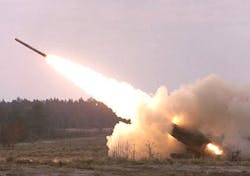Army surveys industry for affordable proximity sensor for GMLRS and ATACMS missile systems
REDSTONE ARSENAL, Ala., 10 May 2013. U.S. Army missile experts are surveying industry to find companies able to build an affordable proximity sensor for the Guided Multiple Launch Rocket System (GMLRS) and Army Tactical Missile System (ATACMS) to detonate air bursts for precision missile strikes.
The Army Research, Development, and Engineering Command (RDECOM) at Redstone Arsenal, Ala., has issued a sources-sought notice (W31P4Q-13-R-0127) for the High Speed Proximity Sensors to Support Guided Multiple Launch Rocket System (GMLRS) Missile program.
AMRDEC officials are interested in a proximity sensor that can integrate with the GMLRS and ATACMS with little or no modification, with leeway allowed for antenna integration and interface board to manage communications from the proximity electronics to the system guidance section and electronic safe and arm fuze (ESAF).
Innovative concepts for the quick integration, test, and fielding of the proximity sensor at any location on the body except for the nose tip or motor are welcome.
Army researchers would like to conduct hardware-in-the-loop testing before the end of March 2014, and flight tests in a GMLRS no later than June 2014.
The goal of the program is to produce a technology readiness level (TRL) 7 reduced-cost proximity sensor that adds capability to the current system. TRL 7 refers to a prototype near or at an operational system.
Army researchers want a proximity sensor that costs less than $3,000, based on a quantity of 1,600 per year. The sensor must measure height above ground from 3 to 130 feet. The proximity sensor must operate at 820 to 2,800 feet per second.
The proximity sensor must be capable of being powered off and on during flight and shall start sensing and ranging no later than 250 milliseconds after the sensor has been enabled. The sensor also must weigh no more than 1.1 pounds.
Companies interested should respond with white papers no longer than 25 pages no later than 21 May 2013. Email responses to the Army's Amanda Horton at [email protected].
For questions or concerns the Army's Tammy Benson by email at [email protected]. More information is online at https://www.fbo.gov/notices/aa460049006a05447501704e8ebe1e77.
